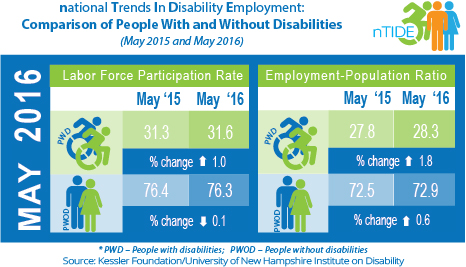DURHAM, NH – The major economic indicators rose for the second consecutive month for people with disabilities, according to today's National Trends in Disability Employment – Monthly Update (nTIDE), issued by Kessler Foundation and University of New Hampshire’s Institute on Disability (UNH-IOD). There are many ways for people with disabilities to develop job-related skills. Sports, for example, provide more than just recreational opportunities. Active participation helps individuals expand their contacts, and develop physical, cognitive and social skills that they can contribute to the workplace.

In the Bureau of Labor Statistics’ Jobs Report released Friday, June 3, the employment-to-population ratio for working-age people with disabilities increased from 27.8 percent in May 2015 to 28.3 percent in May 2016 (up 1.8 percent; 0.5 percentage points). For working-age people without disabilities, the employment-to-population ratio also increased from 72.5 percent in May 2015 to 72.9 percent in May 2016 (up 0.6 percent; 0.4 percentage points). The employment-to-population ratio, a key indicator, reflects the percentage of people who are working relative to the total population (the number of people working divided by the number of people in the total population multiplied by 100).
“The employment-to-population ratio for people with disabilities continued to show improvement this month compared to the same month last year,” according to John O’Neill, Ph.D., director of Employment and Disability Research at Kessler Foundation. “This is the second consecutive month that we’ve seen improvement, which is certainly good news but probably cannot be considered a trend as yet.”
The labor force participation rate for working-age people with disabilities increased from 31.3 percent in May 2015 to 31.6 percent in May 2016 (up 1.0 percent; 0.3 percentage points). For working-age people without disabilities, the labor force participation rate remained relatively constant, decreasing from 76.4 percent in May 2015 to 76.3 percent in May 2016 (down -0.1 percent; -0.1 percentage points). The labor force participation rate is the percentage of the population that is working or actively looking for work.
“It is always good to see both the labor force participation rate AND the employment-to-population ratio increase. It means that more people with disabilities are working and more people are actively looking for work,” said Andrew Houtenville, Ph.D., associate professor of economics at UNH. With regard to trends, he added that “while two consecutive months of employment growth for people with disabilities is very encouraging news, it does not mean we are out of the woods. There is still a long way to go before people with disabilities reach their pre-Great Recession employment levels.”
Networking, skill development, social interaction, and sharing in community activities are all benefits of participating in sports. All of these are also important preparation for finding jobs and excelling in the workplace, which is why Kessler Foundation supports inclusion of people with disabilities in competitive sports. Over the Memorial Day weekend, two events highlighted the Foundation’s commitment – the 15th Kessler Foundation Wheelchair 10K, part of the annual Ridgewood Run in Ridgewood, NJ, which once again attracted experienced racers from many countries, and the 46th Tri-State Wheelchair & Ambulatory Games, a local competition for youth with disabilities, held in Hillsdale, NJ. “Sponsoring these events helps provide valuable experiences for athletes with disabilities,” said Elaine E. Katz, senior VP of grants and communications at Kessler Foundation. “While inspiring others with disabilities to explore their full potential,” Katz observed, “these athletes bolster their qualifications for higher education and meaningful careers.”
In May 2016, among workers ages 16-64, the 4,506,000 workers with disabilities represented 3.2 percent of the total 142,602,000 workers in the U.S.
The next nTIDE will be issued on Friday, July 8, 2016.
Join our new Lunch & Learn series, starting today, June 3 at 12:00PM EST. This live broadcast hosted via Zoom Webinar will offer attendees Q&A on the latest nTIDE findings, provide news and updates from the field of Disability Employment, as well as host invited panelists to discuss current disability-related findings and events. Chai Feldblum, a commissioner of the EEOC, joins Dr. Houtenville and Dr. Michael Gamel-McCormick to discuss today’s findings. You can join live, or watch the recordings at www.ResearchonDisability.org/nTIDE.
NOTE: The statistics in the National Trends in Disability Employment – Update are based on Bureau of Labor Statistics numbers, but are NOT identical. They have been customized by the University of New Hampshire to efficiently combine the statistics for men and women of working age (16 to 64).
nTIDE is funded, in part, by grants from the National Institute on Disability, Independent Living and Rehabilitation Research (NIDILRR) (90RT5022-02-00 & 90RT5017) and Kessler Foundation.
The Institute on Disability (IOD) at the University of New Hampshire was established in 1987 to provide a university-based focus for the improvement of knowledge, policies, and practices related to the lives of persons with disabilities and their families. Its mission is to promote full access, equal opportunities, and participation for all persons by strengthening communities and advancing policy and systems change, promising practices, education, and research.
The University of New Hampshire, founded in 1866, is a world-class public research university with the feel of a New England liberal arts college. A land, sea, and space-grant university, UNH is the state's flagship public institution, enrolling 12,200 undergraduate and 2,300 graduate students.
